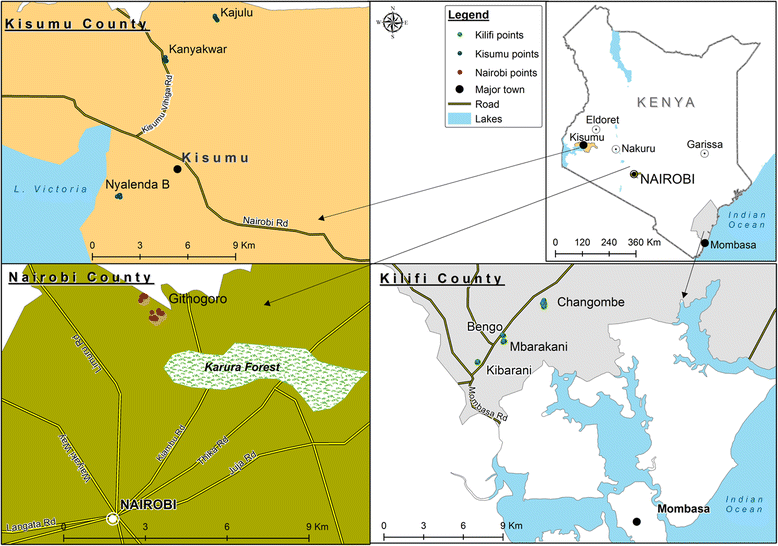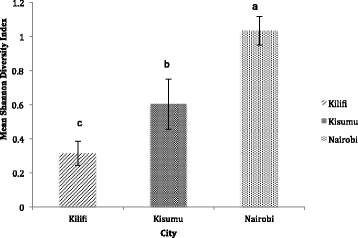Dengue and yellow fever virus vectors: seasonal abundance, diversity and resting preferences in three Kenyan cities
- PMID: 29284522
- PMCID: PMC5747025
- DOI: 10.1186/s13071-017-2598-2
Dengue and yellow fever virus vectors: seasonal abundance, diversity and resting preferences in three Kenyan cities
Abstract
Background: The transmission patterns of dengue (DENV) and yellow fever (YFV) viruses, especially in urban settings, are influenced by Aedes (Stegomyia) mosquito abundance and behavior. Despite recurrent dengue outbreaks on the Kenyan coast, these parameters remain poorly defined in this and other areas of contrasting dengue endemicity in Kenya. In assessing the transmission risk of DENV/YFV in three Kenyan cities, we determined adult abundance and resting habits of potential Aedes (Stegomyia) vectors in Kilifi (dengue-outbreak prone), and Nairobi and Kisumu (no dengue outbreaks reported). In addition, mosquito diversity, an important consideration for changing mosquito-borne disease dynamics, was compared.
Methods: Between October 2014 and June 2016, host-seeking adult mosquitoes were sampled using CO2-baited BG-Sentinel traps (12 traps daily) placed in vegetation around homesteads, across study sites in the three major cities. Also, indoor and outdoor resting mosquitoes were sampled using Prokopack aspirators. Three samplings, each of five consecutive days, were conducted during the long-rains, short-rains and dry season for each city. Inter-city and seasonal variation in mosquito abundance and diversity was evaluated using general linear models while mosquito-resting preference (indoors vs outdoors) was compared using Chi-square test.
Results: Aedes aegypti, which comprised 60% (n = 7772) of the total 12,937 host-seeking mosquitoes collected, had comparable numbers in Kisumu (45.2%, n = 3513) and Kilifi (37.7%, n = 2932), both being significantly higher than Nairobi (17.1%, n = 1327). Aedes aegypti abundance was significantly lower in the short-rains and dry season relative to the long-rains (P < 0.0001). Aedes bromeliae, which occurred in low numbers, did not differ significantly between seasons or cities. Mosquito diversity was highest during the long-rains and in Nairobi. Only 10% (n = 43) of the 450 houses aspirated were found positive for resting Ae. aegypti, with overall low captures in all areas. Aedes aegypti densities were comparable indoors/outdoors in Kilifi; but with higher densities outdoors than indoors in Kisumu and Nairobi.
Conclusions: The presence and abundance of Ae. aegypti near human habitations and dwellings, especially in Kilifi/Kisumu, is suggestive of increased DENV transmission risk due to higher prospects of human vector contact. Despite low abundance of Ae. bromeliae suggestive of low YFV transmission risk, its proximity to human habitation as well as the observed diversity of potential YFV vectors should be of public health concern and monitored closely for targeted control. The largely outdoor resting behavior for Ae. aegypti provides insights for targeted adult vector control especially during emergency outbreak situations.
Keywords: Aedes aegypti; Aedes bromeliae; Dengue and yellow fever risk; Kenya; Mosquito diversity; Resting preference; Urbanization; Vector abundance.
Conflict of interest statement
Ethics approval and consent to participate
We sought permission from household heads through oral informed consent to allow their residences to be surveyed for resting mosquitoes. Household survey of mosquitoes was carried out with ethical approval from Kenya Medical Research Institute Scientific and Ethics Review Unit (KEMRI-SERU) (Project Number SERU 2787).
Consent for publication
Not applicable.
Competing interests
The authors declare that they have no competing interests.
Publisher’s Note
Springer Nature remains neutral with regard to jurisdictional claims in published maps and institutional affiliations.
Figures


References
-
- Sang RC. Dengue in Africa. In: report of the scientific working group meeting on dengue. Geneva: WHO special programme for research and training in tropical. diseases. 2007:50–2. http://apps.who.int/iris/bitstream/10665/69787/1/TDR_SWG_08_eng.pdf
Publication types
MeSH terms
Grants and funding
LinkOut - more resources
Full Text Sources
Other Literature Sources

